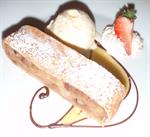Restaurant Management
FOOD SERVICE MANAGEMENT
 The organisation of work in the kitchen will depend on the type and size of operation, and the ratio of semi skilled or unskilled to skilled workers being used (maybe 1:3).
The organisation of work in the kitchen will depend on the type and size of operation, and the ratio of semi skilled or unskilled to skilled workers being used (maybe 1:3).
Mechanisation and the use of convenience foods have altered jobs in the kitchen significantly, and shrinking profit margins require more efficient and profitable working. It is therefore very important to train and develop staff (succession planning), not only in technical skills, but also in supervisory and management skills.
It is essential to control materials (now an increasing cost factor in receipt), storage, preparation, cooking and service, and the elimination of waste. Quality control is practiced on a more sophisticated basis, and standardised operational instructions call for precise menu production to consistent standards.
Menu and Production Planning
This planning may be the work of a group decision by managers -not just the chef.
One appreciates that the skilled chef, in designing his menu, takes into account previous sales figures, which are customer preferences. He needs to consider the menu balance, texture, flavour, taste, blend of different cooking methods, and the use of left overs (perhaps). He will take account of his staff, and their ability to produce any standard or variable menu, using the equipment available.
METHODS OF KITCHEN PRODUCTION
Forms of kitchen production can include:
*A La Carte Production
This should be defined as the traditional method of the conventional or partie system. The menu offers a wide choice of dishes and prices. On the kitchen production side a certain amount of mise an place, or advance preparation is done for each service, for example, garnishes, sauces and the like.
Apart from this, all dishes ordered sur la commande are cooked to order. This requires a flexible system in the kitchen, and relies upon the work of skilled staff.
*Table d'Hote Production
A set menu is easier to organise and produce in a kitchen. It consists of each section of the kitchen department producing a set number of portions of each course at each meal service. The meal can then be dished up and served from a hot plate as required. This is a straightforward service and it is one that can be geared to a personal waiter or waitress service, or to various forms of self service (eg. buffet). This is less onerous than a la carte, and may not require such a high degree of skill from staff. This system allows generous portions to be produced at lower cost.
*Call-Order Production
This is the type of service used to provide room service meals in a hotel. It requires less equipment than for an a la carte operation. The menu is normally restricted in size and scope, and is commonly made up of convenience, easy to prepare foods. Typical equipment needed might be refrigerators, grills, toasters, deep fryers, microwaves and convection ovens.
*There are also other systems such as:
- a very sophisticated a la carte system (where no food is pre prepared), or
- a simpler system, where all food is served cold (eg. fruit, ice cream, sandwiches, etc).
HOW TO LEARN MORE
Read a book, do a course, join an organisation; talk to people, observe the world.
Contact us -Talk to an Academic Officer
We provide a FREE COURSE AND CAREER COUNSELLING SERVICE
Learn from our experience.
[24/04/2024 21:22:05]